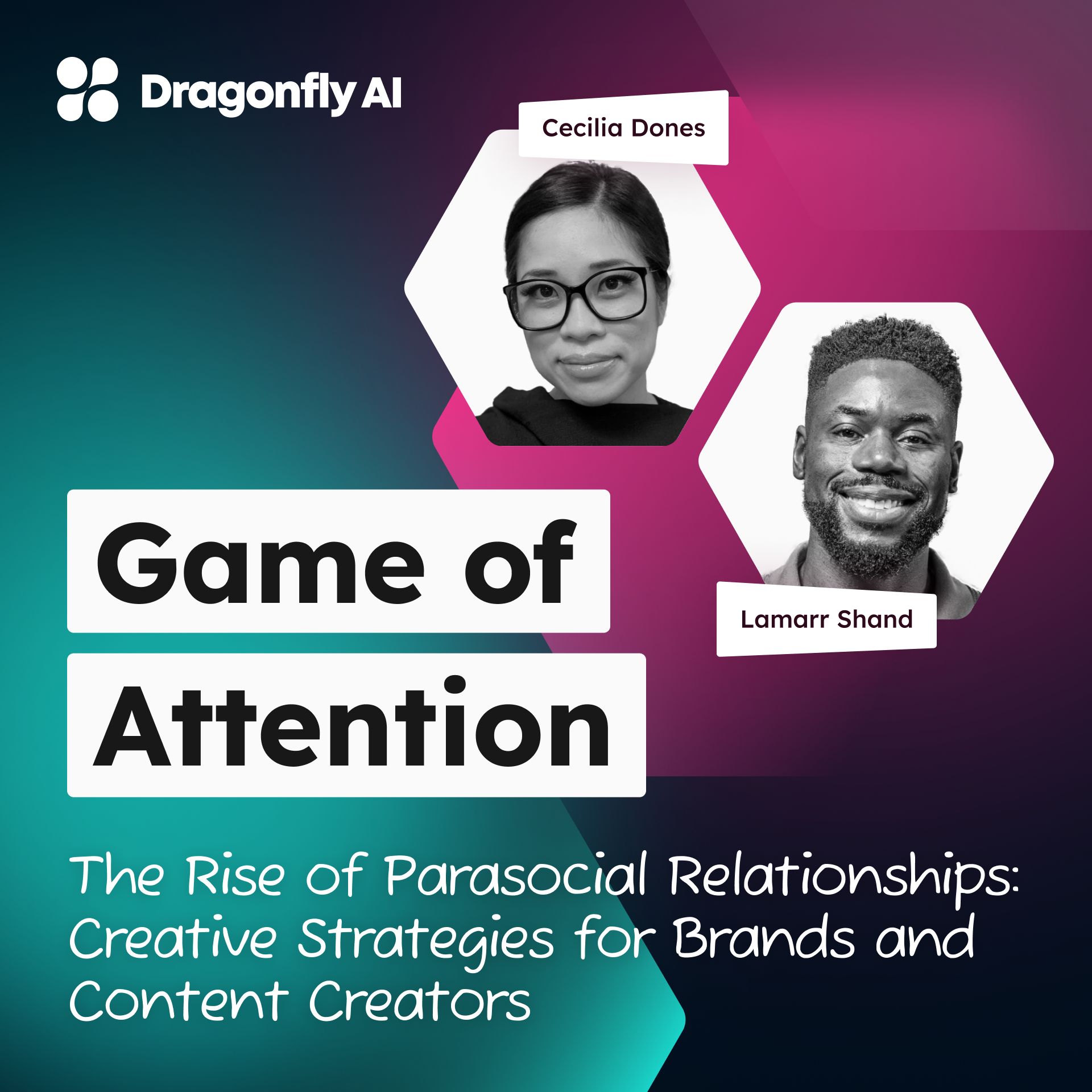Dragonfly AI is a predictive analytics platform designed to help you improve the quality and effectiveness of your creative across any format, channel and market.
Parasocial Relationships: Creative Strategies for Brands and Content Creators
Expert-led podcast discussing trending articles, and news in the AI and attention spaces.

Webcasts led by experts
From parasocial relationships to cultural shifts in media consumption, Lamarr Shand, Head of YouTube & Digital Video Strategy at Google, and Ceci Dones, Founder at 3 Standard Deviations, discuss how brands can leverage emerging AI tools like predictive creative testing to enhance authenticity and personalization, the importance of quality creative, cultural nuances, and so much more.
Watch the full episode above.
Q: What role does high quality creative play in forming strong parasocial bonds with audiences? In what ways does focusing on quality impact trust and engagement with followers?
Lamarr: When you think about how a creator consistently delivers authentic high-quality work. What readers and consumers see is that they're genuine, they're passionate, they're invested in their audience. This perceived authenticity wants them to engage a lot more with creators. The other thing is around emotional connection. Think about that connection to humor or storytelling, visual elements. These are all the other elements that build that engagement.
We are always deciding where we invest our time, whether it's on social platforms, TV, friends, et cetera. When you have this perceived quality, there's increased investment from your consumers, from people who watch your content, and thereby it most likely forms even stronger parasocial bonds. High quality creative is so important within this forum.
Ceci: We originally studied these things when we were thinking about television personalities. You watch the same shows over and over again, you watch the same newscasters over and over again, and suddenly you start to believe that, gosh, I kind of know them. I know a little bit about their background. They talk about their weekends, they talk about their family, et cetera, et cetera. But these newscasters, these celebrities, they don't know you individually. So, when we extend these ideas into digital and virtual spaces, it gets really exciting that we have these influencers. We have individuals that we actually depend on for information on platforms like YouTube, platforms like TikTok, platforms where there is social media. Suddenly you have these individuals starting to have attachments to these influencers. Then it gets amplified even further when we think about AI, because now we have things like chat pods that are mimicking more and more of human behavior.
When we think about parasocial relationships, we're thinking about authenticity and trust. It’s about how do I show up in a way that's one, ethical, and two, going to deliver value for consumers?
Lamarr: It also plays into specific shifts in media and consumption habits. We've seen four specific shifts. From broadcasts, where you saw your news anchor, to cables, you think about CNN. Now we think about we're in a shift of streaming and we've shifted now to social video. Consumers are spending nearly 60 % of their digital watch time with social video and CTV. It makes sense that these bonds are even forming a lot stronger and more intensely because we just have so much interaction with creators and influencers.
I think the other portion to that is around culture. Our culture is also becoming a lot more fragmented. So, we think about culture in two different segments. One around monoculture through top-down big moments like Super Bowl you think of the moon landing.
Then we think about trending discourse, and I think this is where a lot of creators and influences come in. This is more bottoms up. It's organic. It's viral. It's like the brat summer. It's like the ice bucket challenge. Thinking about the impact of media and media habits and the fragmentation of culture are also things that are at this tension and driving this intensity of parasocial relationships as well.
Ceci: When we think more traditionally academically about the definition culture, we're thinking about attitudes, beliefs, values, and norms that we reinforce through ritual. The challenge for a lot of brands is when we're thinking about the ice bucket challenge, when we're thinking about the cinnamon challenge and all the other challenges that could potentially come up. Are those things just, are they helping to reinforce the values that the brand wants to reinforce with the consumer? Is it reinforcing norms? Is it reinforcing beliefs?
Lamarr: The implications that for brands from everybody from the CMO to the CFO to IT to a brand manager, there needs to be a mindset shift to understand that we need to go where the watch time is, we need to go where consumers are watching.
Creators are producing more content and the fact that consumers are watching more creative produced content, we don't see that shift slowing down anytime soon.
Ceci: How your consumer is responding to your advertising or marketing in a way that you can actually take action upon. You need that feedback to further the relationship. And then experimentation. It can be a little bit risky, especially when we're thinking about some of these newer technologies.
I always encourage any clients, regardless of size, that even if the experiment is small, you're still practicing that muscle of trying to learn. And that's so important, especially when you're trying to navigate these newer technology spaces.
Q: How can brands and creatives use creative visual elements to foster a sense of community amongst their followers?
Ceci: Symbols are a great way of creating group identities, a great way of reinforcing certain mindsets, certain ways of thinking. Brands who already have a rich sense of what those symbols are could definitely use that in newer spaces to introduce consumers to more novel experiences. For example, Coca-Cola, it's very obvious when we see that brand. Apple, very obvious when you see that brand. Google, same way, very obvious when you see that brand. Thinking about it as a brand, what are those symbols? It doesn't have to always be visual. It can be auditory.
I think for brands who are trying to think about visual cues or auditory cues, understanding what's already in your portfolio so you can leverage that in new experiences. If you don't have all of these things in place, this is actually a great opportunity.
Lamarr: Think about the evolution of media and social networks and how they influence, parasocial relationships. YouTube was founded in 2005 and it was the first platform that allowed this parasocial relationship to exist on a different scale. Creators could share and upload their videos. It's just so interesting to see how we've evolved from this social networking to now, a lot more people consider themselves content creators.
Q: As brands are trying to kind of connect on this authentic personal level, what traditional advertising tactics are still useful and how can they be adapted as we move ahead with technology?
Ceci: Experimentation is the scientific method that we all learned in grammar school and primary school, that is always going to still be key. Why? Because at the end of the day, we're always trying to learn in the space because the space is changing and dynamic. I would say that is a core pillar of a foundation that regardless of the technology, that experimentation, that scientific method is going to be so key for marketers to be successful. And then I would say a humility. And why do I say humility? Because the space is so new. I would say that humility around learning, in addition to the scientific method, is key for marketers, regardless of the changes in technology.
Never forget the person. Never forget the people. The ones and zeros at scale is beautiful and it's really wonderful to see it work. But it's still only ones and zeros. The ultimate nuances that make every individual unique and create a unique value for that individual, still about the people. So sometimes I have to remind marketers, who is your customer? Who are we doing this for? We're doing this for people.
Lamarr: A lot of the brands I work with, they're always optimizing for the most efficient reach as possible. So cheap reach, strong effectiveness.
But the reality is you need to go where your consumers are watching and who they're watching. I think going where your consumer is super important because that's going to drive the most ROI.
Q: How are emerging AI tools like predictive creative testing influencing the way that these relationships are built and how does it impact authenticity?
Ceci: It can be between 60 to 80 % that the productivity of an ad is due to the content, the creative itself. The media is great. is going to do the delivery component, but it's a channel. Getting the creative right is so critical.
Not only can technology help us create all the variants and all the variations we need for this personalization to be authentic to how the consumer wants to receive that brand, we also have the technologies and tools to help us measure and see those signals from the consumer. Brands need to use both levels of technology to help them listen to their consumer and deliver that personalized experience.
An incredible discussion with two industry experts and what a privilege to host them on Game of Attention.
Please watch the full episode above for further insights.
Alternatively listen on Spotify here.
And don’t forget to subscribe here.


